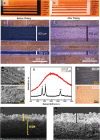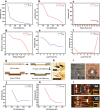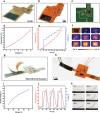Laser-Enabled Fabrication of Flexible Printed Electronics with Integrated Functional Devices
- PMID: 40040310
- PMCID: PMC12120706
- DOI: 10.1002/advs.202415272
Laser-Enabled Fabrication of Flexible Printed Electronics with Integrated Functional Devices
Abstract
The demand for flexible and printed electronics in wearable and soft robotics applications has increased the need for scalable, additive manufacturing processes. However, traditional printed circuit board manufacturing involves complex, multistep processes, is limited to certain substrates, and faces challenges in integrating functional devices. Here, an additive, laser-enabled process is introduced for fabricating flexible, double-sided printed electronics leveraging laser-induced graphene (LIG) as a seed layer for selective copper electrodeposition (E-LIG). This technique enables precise conductive circuit patterning down to 50 µm and is reliable via formation in a single streamlined process. E-LIG supports transfer to various substrates, allowing for large-area electronics up to 100 cm2, broadening applications in large-scale interfaces. Functional LIG device integration, including sensors and actuators, directly interfaced with control circuits on a single substrate is demonstrated. Applications such as real-time graphical output and interactive interfacing showcase the method's versatility. E-LIG exhibits repairability for on-demand restoration of damaged circuits, enhancing durability and offering a scalable, cost-effective solution for multifunctional printed electronics.
Keywords: additive manufacturing; digital fabrication; flexible electronics; laser writing; printed electronics.
© 2025 The Author(s). Advanced Science published by Wiley‐VCH GmbH.
Conflict of interest statement
The authors declare no conflict of interest.
Figures






References
-
- Gao W., Ota H., Kiriya D., Takei K., Javey A., Acc. Chem. Res. 2019, 52, 523. - PubMed
-
- Corzo D., Blazquez G. T., Baran D., Front. Electron. 2020, 1, 594003.
-
- Khan Y., Thielens A., Muin S., Ting J., Baumbauer C., Arias A. C., Adv. Mater. 2020, 32, 1905279. - PubMed
-
- El‐Atab N., Mishra R. B., Al‐Modaf F., Joharji L., Alsharif A. A., Alamoudi H., Diaz M., Qaiser N., Hussain M. M., Adv. Intell. Syst. 2020, 2, 2000128.
-
- Hussain M. M., El‐Atab N., Handbook of Flexible and Stretchable Electronics, CRC Press, Boca Raton, FL: 2019.
LinkOut - more resources
Full Text Sources
